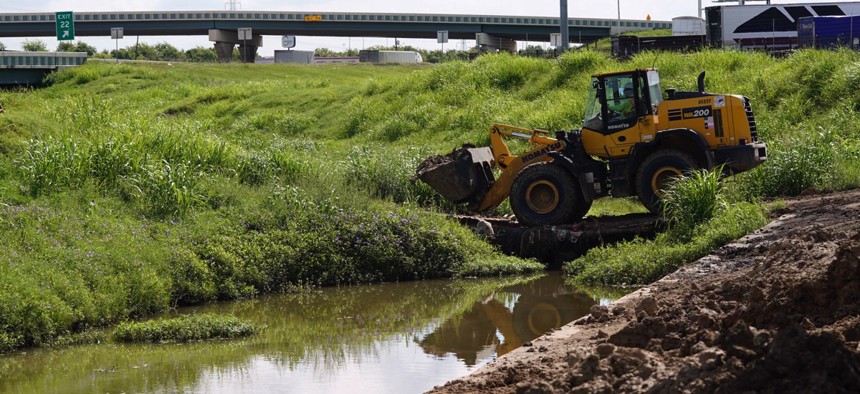Most Texas Localities Are Still Growing a Year After Hurricane Harvey

Work continues along Hunting Bayou in Houston. The bayou was one of many that overflowed during Hurricane Harvey. David J. Phillip / AP Photo
A new Moody’s report shows that a combination of reconstruction, continued population growth and federal assistance have helped.
Most local governments in Texas affected by Hurricane Harvey continue to see tax base growth and maintain credit quality a year after the disaster due largely to reconstruction, according to a recent Moody’s Investors Service report.
Harvey, the second-costliest hurricane in U.S. history after Katrina, caused $125 billion in damages, the National Oceanic and Atmospheric Administration has estimated, but homeowners and business rebuilding have increased sales tax revenues.
Of the 13 Texas counties hardest hit by Harvey, nine show an increase in fiscal 2019 assessed value, Moody’s said.

Hurricane Harvey came ashore on Aug. 25, 2017 near Corpus Christi, Texas, then stalled out in the Houston area, dumping record amounts of rainfall across the region for days and causing extensive flooding in and around the nation’s fourth-largest city.
Continued population growth in the Houston metropolitan area and significant federal recovery assistance also helped prevent declines.
Harris County, home to Houston, is looking at a FY19 AV of 2.8 percent—close to the previous year’s increase. And Houston’s FY19 AV increased 2.1 percent to $234.1 billion, compared to 2.9 percent growth in 2018, according to preliminary data.
Port Arthur, the only city government in the region to see a credit downgraded by Moody’s after Harvey, has a flat FY19 AV.
School district AVs generally increased despite Harvey-related declines in enrollment, as did those for most municipal utility districts, which saw relatively little flood damage, per the report. Harris County Utility District 6 was the exception—downgraded after Harvey due to major flood damage.
New residential construction has slowed a bit after Harvey, limiting municipal utility district AV growth more than other sectors.
“While other areas may lack benefits enjoyed by Texas, local governments generally maintain credit quality following a weather event because of the immediate spike in sales tax collections, as well as a relatively quick, usually within two years, property value recovery,” according to the report. “Often temporary property value loss is revenue neutral due to the financial flexibility of governments to raise rates.”
Dave Nyczepir is a News Editor at Government Executive’s Route Fifty and is based in Washington, D.C.

NEXT STORY: States Make More Progress Rebuilding Rainy Day Funds






